Notes on rearing Giant Atlas Moth (Attacus atlas) in the UK
by Alan Marson
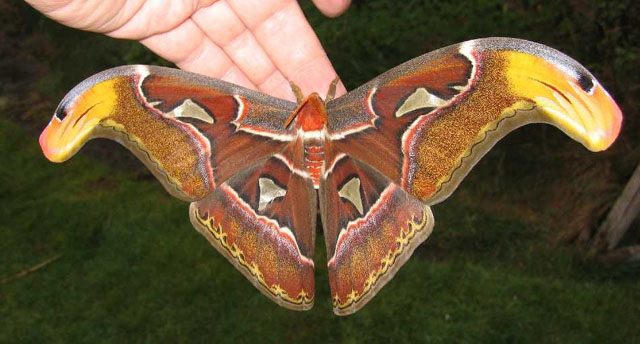

Background:
Many people in the UK have acquired A. atlas livestock and the species is easy and cheap to obtain these days as imported cocoons from South-East Asia. However, I do wonder just how successful amateur entomologists are at rearing and breeding them? Personally I have reared them through on a number of occasions over many years – but I have tended to lose a lot of larvae and not end up with many home reared cocoons. They are also less easy than many other Saturniid species to pair in captivity – which probably explains why eggs are relatively infrequently offered for sale despite the large numbers of cocoons imported every year.
In the past I have generally followed the accepted wisdom of giving atlas larvae very warm and humid conditions. However, recent experiences in successfully breeding and rearing Argema mittrei have prompted me to rear A. atlas again and re-evaluate the way in which I keep them. This has been very successful and I decided to write these notes in the hope that they will be useful to others.
Note: A key finding with my A. mittrei stock was that they don’t need excessively hot and humid conditions to thrive. I have reared A. mittrei larvae in the winter indoors but without any extra heat (my house is centrally heated) and, while they take a long time to grow, losses are very low and they end up very large and healthy. The rearing temperature has ranged from 12 to 22°C without any ill effects.
Attacus atlas
The eggs:
These are large – but not particularly so for the size of the moth. (By comparison A. mittrei eggs are huge!) I keep them in plastic boxes and breathe on the inside of the lid occasionally to add a bit of humidity. I’m not sure if this makes a difference. On this occasion I received 20 eggs of A. atlas originating from Vietnam in December 2004. These started hatching on 16th December about 14 days after laying. In total 18 hatched and were put into plastic boxes on Privet. Two larvae didn’t really feed at all and died within a few days leaving me with sixteen 1st instar larvae.
The larvae:
These were kept initially in plastic boxes in a spare room that I use for my insects. The house is centrally heated – but on a timer so throughout the rearing period the temperature in the room ranged from 15 to 20°C. I had decided that I would try rearing the larvae without giving them any extra heat and that I would spread them out so that they had plenty of space. I initially had 4 small larvae in each box (dimensions about 27x 15x10cm) and as they grew I spread them out further. By the time they were in 5th instar they were housed singly in a box of the size described above. After they changed into 6th instar I waited until they were feeding well again and then put some of them on cut privet twigs in water (in milk bottles with the neck plugged!) divided between 3 large rearing cages. The rest were kept singly in the plastic boxes.
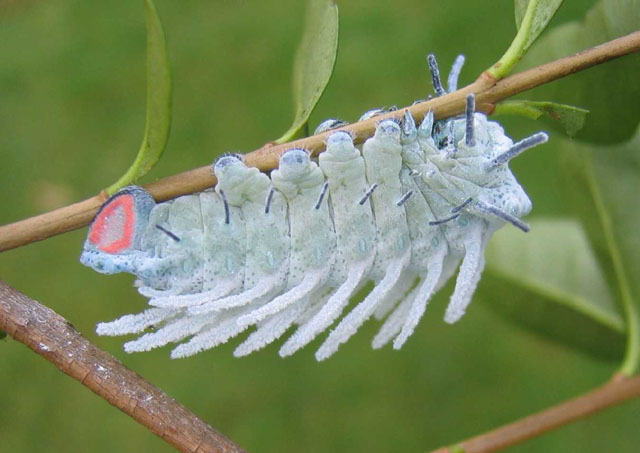
A 5th instar larva soon after its 4th moult.
The larvae took from 49 to 59 days from hatching to spinning. This is longer than previously when I have kept them warmer – but I have never had such a good survival rate. All 16 survived to pupate. So perhaps it’s better to keep them cooler and let them grow at a steady pace. I think that the good survival rate has a lot to do with keeping them well spaced out. Some species seem to tolerate crowding better than others (usually species which are distasteful to predators or have stinging spines and so benefit from living in groups). Species more vulnerable to predation benefit from being spread out.
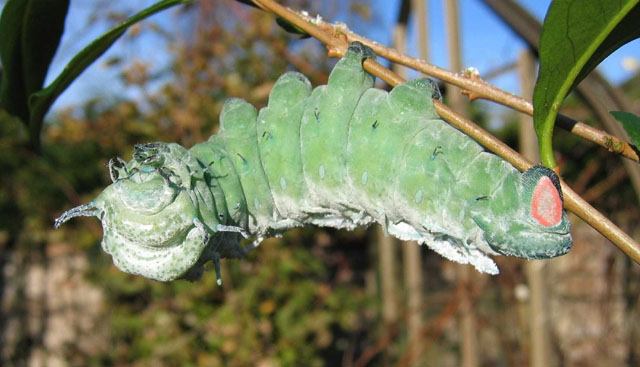
Full grown larva in 6th instar
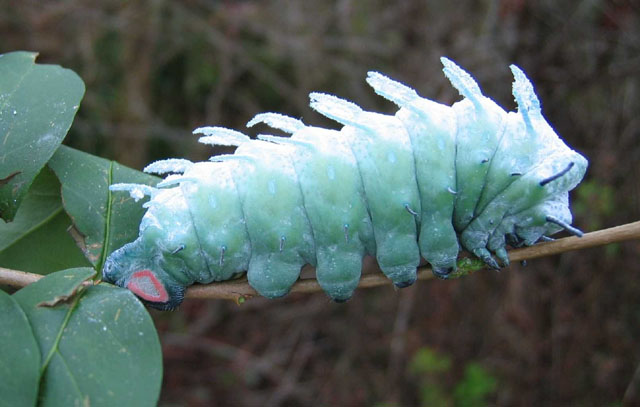
While most Saturnids have 5 larval instars, some species may have 6. For example, when I have reared Antheraea mylitta and Actias maenas most larvae have had 5 instars – but a few have had 6. These have always been large females. In this case all of my A atlas larvae had 6 instars, although from the range of sizes it was obvious that there was a mix of sexes.
The cocoons:
When I have received atlas cocoons from Asia they are normally spun between large leaves. I decided that it might be a good idea to give the larvae some big leaves for spinning! Hence I put some cut twigs of rhododendron in the rearing cages in ‘plugged’ water-filled milk bottles alongside the bottles containing the privet twigs that the larvae were feeding on. Some of the larvae did take advantage of this and spun up between rhododendron leaves. However, others just spun their cocoons at the end of privet twigs – their weight bending the twigs over so that the cocoons hang like fruit.
Incidentally, although Rhododendron is a recorded foodplant for A atlas none of my larvae ate any of it when it was introduced to the boxes. They continued to feed on the privet and only wandered onto the Rhododendron when they were ready to pupate.
The adults:
The first of my adult moths emerged in late March – just over 7 weeks after the larvae started to spin. Emergence is normally no problem for home reared stock. However, I have had problems sometimes with imported cocoons - which I put down to the pupae becoming dehydrated in storage and/or transit.
A atlas has a reputation among amateur entomologists for being difficult to pair in captivity. Kept indoors in a small flight cage it is rare for them to pair naturally even if several pairs are out together. One way round this is to ‘hand pair’ them. This is often quite successful but whether it works or not seems (in my experience) to depend on the male. If the male has a relatively firm abdomen and prominent claspers it is quite easy to hand pair them by manipulating the pair until their genitalia ‘lock’ at which point they can be left on the netting of the cage. They don’t usually pull apart and will stay together until the following day. It is best to try to pair them late at night when the males are flying actively and the females are ‘calling’. However, many males seem to have very soft abdomens and it is not easy to get them to open their claspers to attempt ‘hand pairing’. For males it is best to wait for 2 or 3 days after emergence before attempting hand pairing. Once they have starting flying their bodies are firmer and there is more likelihood of success. Females can be mated earlier if you have a suitable male.
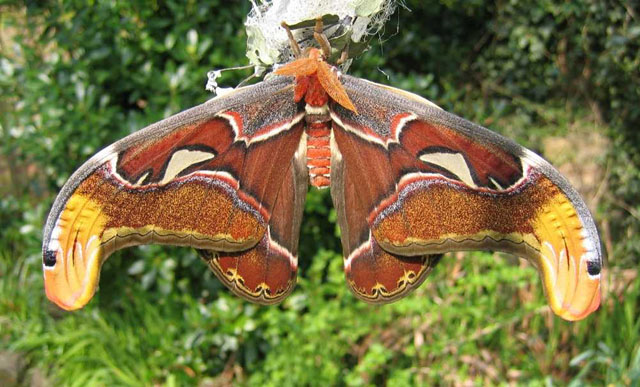
Adult male shortly after emergence.
I find that for natural pairings it is best to hang the pairing cage outdoors (in the summer!). A larger cage is best – but they will even pair outdoors in small netting cages if conditions are right. It seems to be the air movement (breeze) which helps the males to locate and pair with the female. They will even do this when temperatures are quite cool. (See note below on A mittrei.) I have tried to simulate these conditions indoors using electric fans but it has never worked. Hanging them outdoors usually works provided that it is warm enough for the moths to fly.
Note : As people who have read my mittrei notes will know, I have successfully hand-paired this species on a number of occasions now – but they had not paired naturally. Until last June that is! One night last year I left several adult male mittrei and one female in a large cylindrical cage in my garage for the evening. I was intending to bring them indoors and attempt to hand-pair them later on. However, when I got home that evening at about 11.30pm the female was already mated. I checked the temperature in the garage as it was very cool even though it was June. It was 11°C !!
Chronology – Vietnamese Attacus atlas:
Eggs laid around 2/12/04
Hatching started 16th Dec – commenced feeding immediately on Privet
(Ligustrum)
First larva in 2nd instar 24/12
Many larvae in 3rd instar by 4/1/05
First larva in last instar (6th) on 20/1/05
First started spinning 3rd Feb – Last larva (No. 16) started spinning
13th Feb.
First moths emerged 27th & 28th March. (The first 8 moths to emerge
were males.)
Three females emerged 8th, 10th & 11th April. One male also emerged
11th April.
1st pairing (natural) night of 12th/13th April.
That’s 49 to 59 days from hatching to spinning. Just over 7 weeks
from 1st spinning to 1st emerging. Rearing temperature ranged from
15 to 20°C
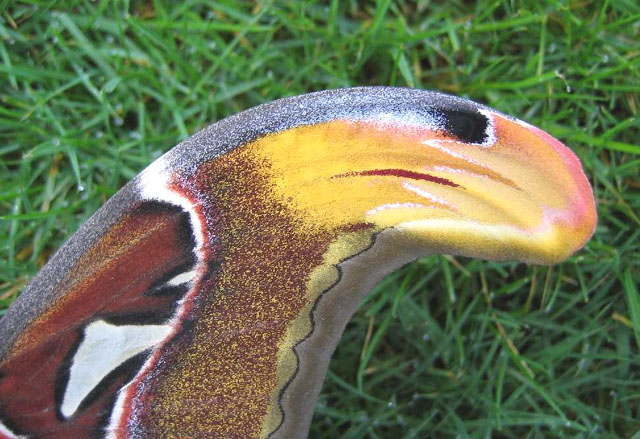
Alan Marson
13th April 2005
Use your browser "Back" button to return to the previous page.